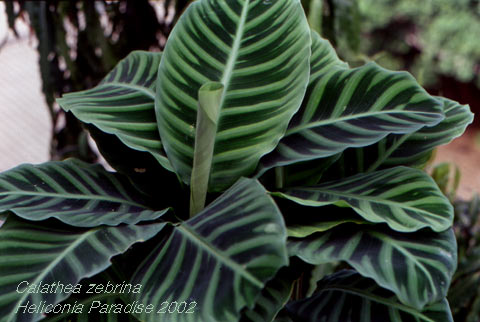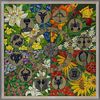Flower EncyclopediaENTER THE WORLD OF FLOWERS |
Other News
Calathea
Category: Decorative leaf
01 Aug : 12:28
To view pictures click on them





 Kalateya representatives of the genus are among the most beautiful and attractive listnodekorativni plants. They have the impressive and exotic coloration of leaves, dotted with spots of interest ranging in size and shape. Come from the tropics of South America, where local people often use their leaves for knitting baskets. It is from there is derived the name of the genus (Kalathos), which translated from Greek means "basket.''Genus includes about 150 species of herbaceous plants.
Kalateya representatives of the genus are among the most beautiful and attractive listnodekorativni plants. They have the impressive and exotic coloration of leaves, dotted with spots of interest ranging in size and shape. Come from the tropics of South America, where local people often use their leaves for knitting baskets. It is from there is derived the name of the genus (Kalathos), which translated from Greek means "basket.''Genus includes about 150 species of herbaceous plants.Kalateite reared for their mottled leaves, but there are exceptions. Calathea crocata is almost monochrome leaves and is most often grown for its bright orange color.
By - some species are C. picturata, C. rebrina, C. Maui Queen. Not all kalatei have rounded leaves, some are sharp copy.
The beauty of Kalateyata in separate sheet - green or mottled colors, with an intriguing pattern and satin shine. Undoubtedly the most popular and impressive is Kalateya makoyana (C. Makoyana). Its leaves are a pale, almost white base color with fine dark green nevratura and larger and smaller dark with a reddish tinge elliptical spots. Given these patterns, and because of the location and shape of leaves and frantsuzite Americans call it the "plant-Peacock (ENG peacock-plant; FF. Plante-paon). Original Kalateya are arable (C. ornata) with pink and silver streaks, K. rozeopikta (C. roseopicta) with a mean streak and stripes in pink and yellow border around the edge of a centimeter of the leaf. Kalateya zebrina (C. zebrina), C. insignis (C. insignis, C. lancifolia), K. veychiana (C. veitchiana) have interesting combinations in light and dark green. Leaves with distinct bright green and yellow spots are characteristic of K. luberzii (C. lubberzii).
Great variety of gorgeously colored leaves of kalateite, but there are species which are distinguished by their colors.
These are: K. Croco (C. crocata), shining with bright orange petals and K. varshevichi (C. warscewiczii) preestni with creamy-white flowers. Location: kalateite are easy to care. The majority of them were moved to Brazil where it grows in tropical forests along the banks of rivers and lakes. Place them in a warm room - the optimum temperature is between 18 and 21bS. In winter the temperature should not fall below 15bS. Sudden changes in temperature regime damaged plant. Are favorable and air currents. Kalateite grow and develop well in polusyanka. Can not tolerate direct sunshine. If the failed to install them on the window, they will react to fading of colors and appearance of leaf scorch, and soon the entire plant will die. The most suitable place in terms of light to grow them in a room with a northern exhibitions.
Humidity: kalateite require high air humidity, especially during active growth from March to September. Most problems associated with growth retardation, turning brown, hair loss and drying of leaves due to dry air. It is therefore necessary to pay special attention to maintaining a high air humidity. Pulverization plants regularly, using tepid boiled water, not to smudge patterns on the leaves. Another way to keep the humidity is like a pot wrap with moist peat or plant planted in a terrarium or garden-bottle.
Irrigation: kalateite drink more water. The soil must be constantly moist. This does not mean that we should preobilno and constant watering. In the best case, the pad should not remain water. Prepolivaneto is equally harmful to the plant as insufficient soil moisture. Both cases lead to deformation of the leaves. Winter irrigation is reduced so that the soil slightly prosahne poured before the next dose of water. Use lukewarm water and boiled.
Feeding: it is performed only during the period of intensive growth - from March to August every two weeks. The most effective way of feeding with liquid fertilizer for decorative leaf. Recommended amount of fertilizer is added to water, which will plant watering - so save your work and avoid any danger of overfeeding. A slurry and is easy to assimilate as opposed to powdered and granulated fertilizers, such as tablets and sticks.
Soil mix: growing older plants need good drainage and roughly screened soil mixture composed of garden soil, peat and leaflet. Experts recommend soil substrate derived from the leaflet burnt manure chimovka, sand and peat in equal volumes. You can buy a ready substrate for palm and mix with peat.
Replanting: kalateite need replanting every two to three years. Transfer to a new court and deposition of dust is made in the spring. Choose a pot that is slightly larger than the previous one. Do not forget to put drainage and be careful not to injure the roots.
Propagation: Divide plants when they are grafted. Cover the pot with the new plant with naelon and maintain sufficient heat, while tackle. Provide high air humidity - such as with polyethylene cover, keep warm (20-22bS) while Pusan plant roots.
Problems: arise as a result of improper breeding, therefore they lose their leaves and decorative rstenieto bring in its original form is a complex task. Under inappropriate conditions kalateite react a certain way. In direct sunlight or high intensity lights appear dry brown spots and patterns to disco. If the air is dry, the leaves begin to dry around the edges and fall off. Preovlazhneniyat substrate or excess fertilizer led to shrinkage of leaves, appearance of yellow spots, hair loss of leaves, a rhizome rot. Drained soil is the cause of withering, rolling the leaves and hair loss PESTS: attacks are most often mealy-bug. First signs of their presence are sticky shed the leaves. Scale insects are removed with a damp cloth and then to spray with a systemic insecticide. Red mite occurs on the lower surface of leaves, and encloses them with thin and barely noticeable cobweb. Damaged leaves gleamed yellow and fall. Daily pulverization is a precautionary measure. In a strong attack with acaricide spray.
| maui queen |
Comments are turned off for this item0
| maui queen |























































